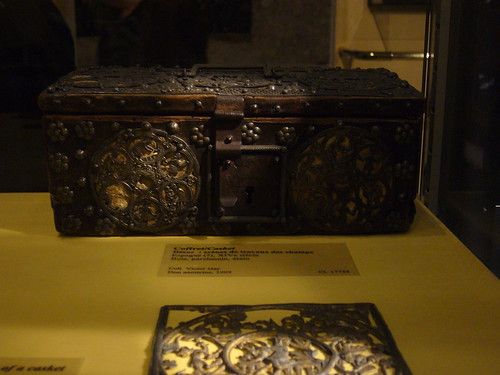Today I thought I'd do a feature on Medieval/Gothic interior decorating, with a couple of inspirational pictures from the Cluny Museum and Musee D'Orsay. Fear not! I'm not going to be discussing creepy black interiors or coffin-shaped beds. Remember, Gothic revival style is actually light, bright and inspired by nature.
So how do you capture a hint of the Medieval without looking like Count Dracula was your decorator? Well, William Morris' design work is a great example of Medieval revival done right. But if you'd like to capture some of those Gothic themes without using Morris as your template, here are some ideas.
Use colours inspired by nature. And focus both on colour and texture when choosing decorating fabrics. You want your room to feel luxurious, and beautifully textured fabrics are one of the best ways to do this. Of course, tapestries are the perfect touch, but they can be rather expensive! Also, a little hint: unless you have the great fortune of living in a castle constructed from brick or stone, your walls probably will need some added spice. Wallpaper adds a great touch, but it's easy to overdo. Please, please do not paint faux stones on your walls. It is the ultimate in tacky!
Here are some common medieval motifs that you might want to incorporate into your home: heraldic themes, such as fleur de lys, trellis designs, roses, lions, dragons and stylised crosses. Obviously, if you include all of these elements in one room it might look completely over the top. The key is simplicity--as always, stick by the tried and true William Morris maxim of avoiding everything that you don't "know to be useful or believe to be beautiful"--never ever fill your house with junk just because you think it somehow "goes" with your chosen decorating theme.
Although people always think Gothic style is about darkness, the opposite is true! Innovations in architecture in the early middle ages had allowed people to start allowing more light into their homes and public buildings. Obviously, one of the most popular ways of allowing light into churches was with stained glass. But stained glass windows can actually be used as a great decorating element in your home. You can find beautiful pieces in antique stores that have been removed from old buildings (it's tragic, I know, but you might as well take advantage of it). Light fixtures in wrought iron or pewter also look great in a Gothic revival home. Candelabras can evoke a more dark romantic mood, but if you keep the design light enough, it doesn't have to look depressing. Try to let in as much natural light as possible.
Furniture should be simple and constructed from natural elements. "Blobjects" are obviously a little more difficult to incorporate, though I have seen some very interesting design work that combines ultra modern plastic furniture with Gothic inspired architecture, but I wouldn't recommend it unless you really trust yourself as an interior designer. I saw this beautiful table at the Musee D'Orsay on Sunday. It's very much inspired by the simplicity of medieval furniture styles, but I love the delicate Art Nouveau interpretation.
For the bedroom: again, you will want to keep it simple. In the Middle Ages, most homes used simple pallets or four poster canopy beds. Wrought iron can look nice as well, but don't overdo it--you don't want your inner sanctum to resemble a dungeon (well, let's hope not).
Finally, resist the urge to collect and display tacky bits of medieval accouterments. I saw this box at the Cluny Museum on Saturday and I was so impressed with all of the delicate iron work! It took me a moment to realize that it was not factory produced--it would have taken an artisan ages to finish all of the design work. Obviously, this kind of time commitment would have made the piece extremely valuable--I doubt that people would have had their homes stuffed with trinkets--it simply was impossible, given how labour-intense the manufacture of these objects was. Something to keep in mind next time I'm tempted to buy something trendy!
True, William Morris had a suit of armour in his home, but then again, he was William Morris and could probably get away with it much more easily than you or I. Same goes for swords, etc.
Thursday, May 15, 2008
Decorating in Gothic Revival Style
Posted by
Margaret
at
7:06 AM
![]()
![]()
Labels: decorating, travel
Subscribe to:
Post Comments (Atom)


1 comment:
Hi Margaret,
Very Interesting! I recently moved into a house that is Gothic Revival and I believe it was built in 1882, but I am not sure. The oldest deed to the property lists that date.
It has been added on to and changed a lot. It probably had gingerbread jigsaw trim at one point.
The red brick wainscoting was added in 1962.
Come look at the pictures I have on my website:
http://lavidacountry.wordpress.com
Post a Comment